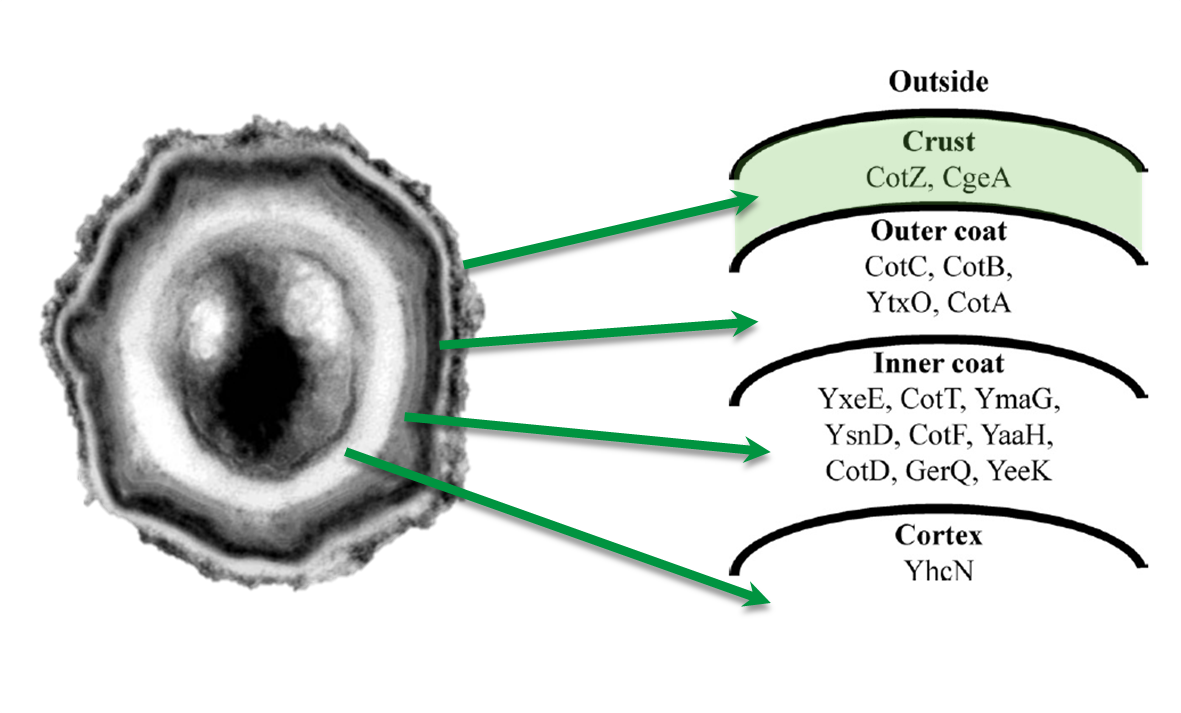Team:LMU-Munich/Spore Coat Proteins
From 2012.igem.org
Franzi.Duerr (Talk | contribs) |
Franzi.Duerr (Talk | contribs) |
||
| Line 55: | Line 55: | ||
<p align="justify">As we are working with B. subtilis spores, we needed to clone our final constructs into an empty Bacillus vector, so that they could get integrated into the genome of ''B. subtilis'' after transformation. Thus we picked the empty vector pSB<sub>BS</sub>1C from our '''''Bacillus''B'''io'''B'''rick'''B'''ox, for the ''cotZ'' constructs. This vector integrates into the ''amyE'' locus in the ''B. subtilis'' genome and therefore we checked the integration of our construct via a starch test. The clones with the right integrated constructs have then been chosen for further analysis. In oder to express both crust protein constructs in one strain the ''cgeA'' fusion proteins had to be cloned into one of the other empty vectors. Unfortunately for unknown reasons, the cloning of the constructs with ''cgeA'' into this vector have been unsuccessful so far.</p> | <p align="justify">As we are working with B. subtilis spores, we needed to clone our final constructs into an empty Bacillus vector, so that they could get integrated into the genome of ''B. subtilis'' after transformation. Thus we picked the empty vector pSB<sub>BS</sub>1C from our '''''Bacillus''B'''io'''B'''rick'''B'''ox, for the ''cotZ'' constructs. This vector integrates into the ''amyE'' locus in the ''B. subtilis'' genome and therefore we checked the integration of our construct via a starch test. The clones with the right integrated constructs have then been chosen for further analysis. In oder to express both crust protein constructs in one strain the ''cgeA'' fusion proteins had to be cloned into one of the other empty vectors. Unfortunately for unknown reasons, the cloning of the constructs with ''cgeA'' into this vector have been unsuccessful so far.</p> | ||
| - | <p align="justify">We were able to construct | + | <p align="justify">We were able to construct five ''B. subtilis'' strains with the following constructs integrated into the ''amyE'' locus: |
<br> P<sub>''cotYZ''</sub>-''cotZre''-''gfp''-''terminator'' | <br> P<sub>''cotYZ''</sub>-''cotZre''-''gfp''-''terminator'' | ||
<br>P<sub>''cotYZ''</sub>-''cotZin''-''gfp''-''terminator'' | <br>P<sub>''cotYZ''</sub>-''cotZin''-''gfp''-''terminator'' | ||
| Line 65: | Line 65: | ||
<p align="justify">Finally we could start with the important experiment for our GFP-'''Sporo'''beads, fluorescence microscopy. Therefore we developed a sporulation protocol, that increases the rates of mature spores in our mutant samples (for details see link). The cells were fixed on agarose-pads and imaged in bright field and excited in blue wavelength.</p> | <p align="justify">Finally we could start with the important experiment for our GFP-'''Sporo'''beads, fluorescence microscopy. Therefore we developed a sporulation protocol, that increases the rates of mature spores in our mutant samples (for details see link). The cells were fixed on agarose-pads and imaged in bright field and excited in blue wavelength.</p> | ||
| - | <p align="justify">Because of the low but distinct fluorescence of wildtype sores, we measured and compared the fluorescence intensity of 100 spores per mutant. | + | <p align="justify">Because of the low but distinct fluorescence of wildtype sores, we measured and compared the fluorescence intensity of 100 spores per mutant. The following graph shows a significant difference.... However we worked with the P<sub>''cotYZ''</sub>-''cotZ''-''gfp''-''terminator'' spores for further experiments as these showed the brightest fluorescence. In these experiments we had three different aims. |
<br>The first one was to show that the fusion proteins are really located on the outermost layer. Therefore we investiagted the fluoerscence of our spores after treatment with proteinase K and FRAP (fluorescence recovery after photobleaching). | <br>The first one was to show that the fusion proteins are really located on the outermost layer. Therefore we investiagted the fluoerscence of our spores after treatment with proteinase K and FRAP (fluorescence recovery after photobleaching). | ||
| - | <br>The second aim was to purify the '''Sporo'''beads from vegetative cells, which thereby should be | + | <br>The second aim was to purify the '''Sporo'''beads from vegetative cells, which thereby should be deadened. We chose three different methods for this approach, the treatment with French Press, ultrasound (sonification) or lysozyme. By means of the microscopy results we were able to conclude that lysozyme treatment was the only successful method. Additionally it did not harm the crust fusion proteins as green fluorescence was detectable afterwards. This is why we use this treatment for purifying spores since. |
| + | <br> The last one was to demonstrate the stability of our fusion proteins when faced with stress conditions, like various pH values, high temperature and different salinities.</p> | ||
| + | |||
| + | |||
| + | <p align="justify">Eventually, clean deletions of the native genes should reveal if there is any difference in fusion protein expression. We deleted ''cotZ'' and ''cgeA'' using the cloning method described by [http://www.ncbi.nlm.nih.gov/pubmed?term=New%20Vector%20for%20Efficient%20Allelic%20Replacement%20in%20Naturally%20Nontransformable%2C%20Low-GC-Content%2C%20Gram-Positive%20Bacteria Arnaud ''et al''., 2004]. | ||
| + | |||
Revision as of 16:05, 19 September 2012

The LMU-Munich team is exuberantly happy about the great success at the World Championship Jamboree in Boston. Our project Beadzillus finished 4th and won the prize for the "Best Wiki" (with Slovenia) and "Best New Application Project".
[ more news ]

Spore Crust Proteins
The aim of this project part is to create spores that display fusion proteins on their crust. There are several different proteins forming the spore coat layers of Bacillus subtilis spores. On the outermost layer, the so called spore crust, the CotZ and CgeA proteins are located ([http://www.ncbi.nlm.nih.gov/pubmed?term=imamura%20et%20al.%202011%20spore%20crust Imamura et al., 2011]). This is why we used them to create functional fusion proteins to be expressed on our Sporobeads.
| |
|
The gene cgeA is located in the cgeABCDE cluster and is regulated by its own promoter PcgeA. The cluster cotVWXYZ contains the gene cotZ which is cotranscribed with cotY regulated by the promoter PcotYZ. Another promoter of this cluster PcotV is responsible for the transcription of the other three genes. Those three promoters were evaluated with lux reporter genes to get an impression of their time of activation and their strength (see for more details BacillusBioBrick Box) so they could be used for expression of spore crust fusion proteins.
The first step was to fuse gfp to cgeA and cotZ as a proof of principle. This way we would determine if it is possible to display proteins on the spore crust and if their expression has any effect on spore formation. Therefore we first fused cotZ to its two native promoters, PcotV and PcotYZ, and to PcgeA, which regulates the transcription of cgeA. For cgeA we only used its native promoter PcgeA and the stonger one of the two promoters of the cotVWXYZ cluster, PcotYZ. While gfp was ligated to the terminator B0014 (see [http://partsregistry.org/wiki/index.php?title=Part:BBa_B0014 Registry]). When these constructs were finished and confirmed by sequencing, we fused them together applying the Freiburg standard to create in frame fusion proteins, flanked by one of the three promoters and the terminator.This way we created C-terminal fusion proteins.
But as we did not know if C- or N-terminal fusion would influence the fusion protein expression, our second aim was to construct N-terminal fusion proteins as well. For this purpose we wanted to fuse the genes for the crust proteins cotZ and cgeA to the terminator and gfp to the three chosen promoters. Unsuccessfully, there occured a mutation in the XbaI site during construction of gfp in Freiburg Standard which is why we were not able to finish these constructs.
| |
|
As we are working with B. subtilis spores, we needed to clone our final constructs into an empty Bacillus vector, so that they could get integrated into the genome of B. subtilis after transformation. Thus we picked the empty vector pSBBS1C from our BacillusBioBrickBox, for the cotZ constructs. This vector integrates into the amyE locus in the B. subtilis genome and therefore we checked the integration of our construct via a starch test. The clones with the right integrated constructs have then been chosen for further analysis. In oder to express both crust protein constructs in one strain the cgeA fusion proteins had to be cloned into one of the other empty vectors. Unfortunately for unknown reasons, the cloning of the constructs with cgeA into this vector have been unsuccessful so far.
We were able to construct five B. subtilis strains with the following constructs integrated into the amyE locus:
PcotYZ-cotZre-gfp-terminator
PcotYZ-cotZin-gfp-terminator
PcotV-cotZre-gfp-terminator
PcotV-cotZin-gfp-terminator
PcgeA-cotZre-gfp-terminator
Finally we could start with the important experiment for our GFP-Sporobeads, fluorescence microscopy. Therefore we developed a sporulation protocol, that increases the rates of mature spores in our mutant samples (for details see link). The cells were fixed on agarose-pads and imaged in bright field and excited in blue wavelength.
Because of the low but distinct fluorescence of wildtype sores, we measured and compared the fluorescence intensity of 100 spores per mutant. The following graph shows a significant difference.... However we worked with the PcotYZ-cotZ-gfp-terminator spores for further experiments as these showed the brightest fluorescence. In these experiments we had three different aims.
The first one was to show that the fusion proteins are really located on the outermost layer. Therefore we investiagted the fluoerscence of our spores after treatment with proteinase K and FRAP (fluorescence recovery after photobleaching).
The second aim was to purify the Sporobeads from vegetative cells, which thereby should be deadened. We chose three different methods for this approach, the treatment with French Press, ultrasound (sonification) or lysozyme. By means of the microscopy results we were able to conclude that lysozyme treatment was the only successful method. Additionally it did not harm the crust fusion proteins as green fluorescence was detectable afterwards. This is why we use this treatment for purifying spores since.
The last one was to demonstrate the stability of our fusion proteins when faced with stress conditions, like various pH values, high temperature and different salinities.
Eventually, clean deletions of the native genes should reveal if there is any difference in fusion protein expression. We deleted cotZ and cgeA using the cloning method described by [http://www.ncbi.nlm.nih.gov/pubmed?term=New%20Vector%20for%20Efficient%20Allelic%20Replacement%20in%20Naturally%20Nontransformable%2C%20Low-GC-Content%2C%20Gram-Positive%20Bacteria Arnaud et al., 2004]. <p align="justify"> Project Navigation
| +--+--+--+--+--+--+-- | +--+--+--+--+-- | +--+--+--+--+--+-- | +--+--+--+--+--+-- |

Bacillus BioBrickBOX |

SporeCoat FusionProteins |

Germination STOP |
 "
"








